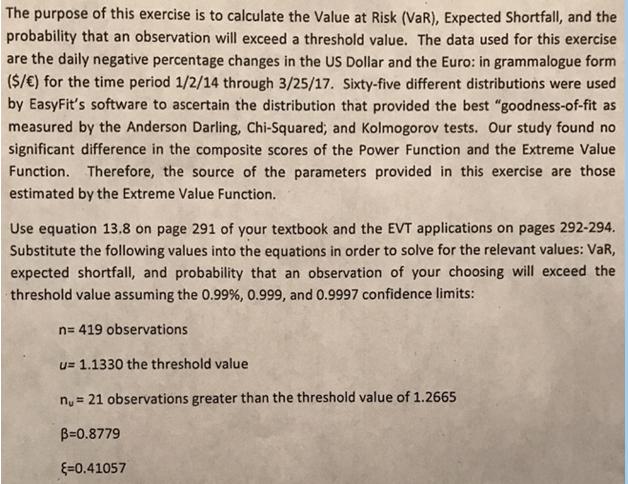Answered step by step
Verified Expert Solution
Question
1 Approved Answer
The purpose of this exercise is to calculate the Value at Risk (VaR), Expected Shortfall, and the probability that an observation will exceed a

The purpose of this exercise is to calculate the Value at Risk (VaR), Expected Shortfall, and the probability that an observation will exceed a threshold value. The data used for this exercise are the daily negative percentage changes in the US Dollar and the Euro: in grammalogue form ($/) for the time period 1/2/14 through 3/25/17. Sixty-five different distributions were used by EasyFit's software to ascertain the distribution that provided the best "goodness-of-fit as measured by the Anderson Darling, Chi-Squared, and Kolmogorov tests. Our study found no significant difference in the composite scores of the Power Function and the Extreme Value Function. Therefore, the source of the parameters provided in this exercise are those estimated by the Extreme Value Function. Use equation 13.8 on page 291 of your textbook and the EVT applications on pages 292-294. Substitute the following values into the equations in order to solve for the relevant values: VaR, expected shortfall, and probability that an observation of your choosing will exceed the threshold value assuming the 0.99%, 0.999, and 0.9997 confidence limits: n= 419 observations u= 1.1330 the threshold value nu= 21 observations greater than the threshold value of 1.2665 B=0.8779 {=0.41057
Step by Step Solution
★★★★★
3.27 Rating (156 Votes )
There are 3 Steps involved in it
Step: 1
ANS WER Value at Risk Va R 0 8 779 Ex pected Short fall 0 410 57 Pro b ability that an observation w...
Get Instant Access to Expert-Tailored Solutions
See step-by-step solutions with expert insights and AI powered tools for academic success
Step: 2

Step: 3

Ace Your Homework with AI
Get the answers you need in no time with our AI-driven, step-by-step assistance
Get Started


